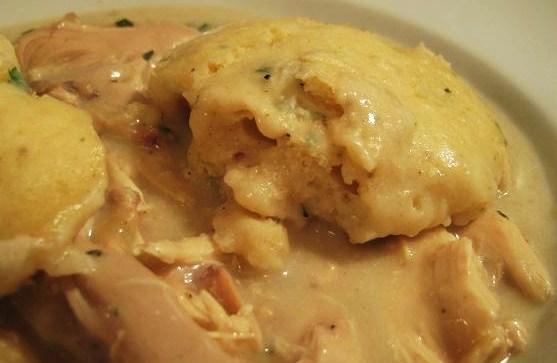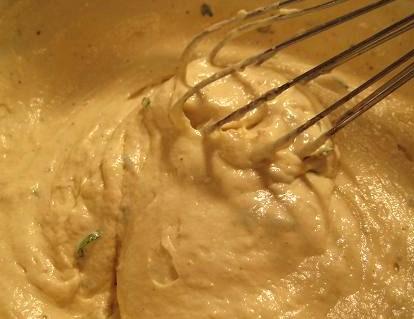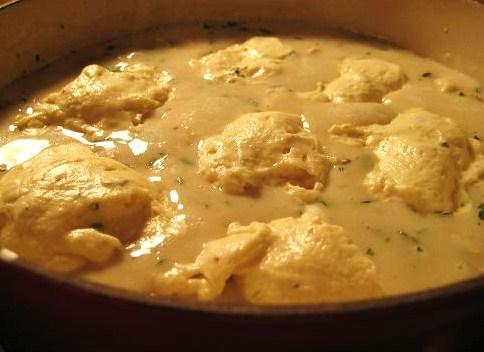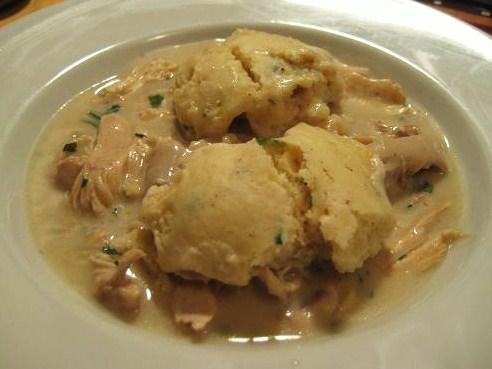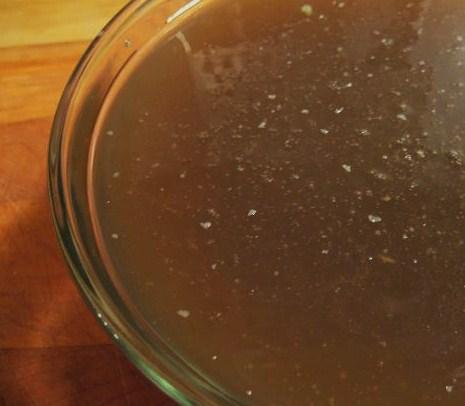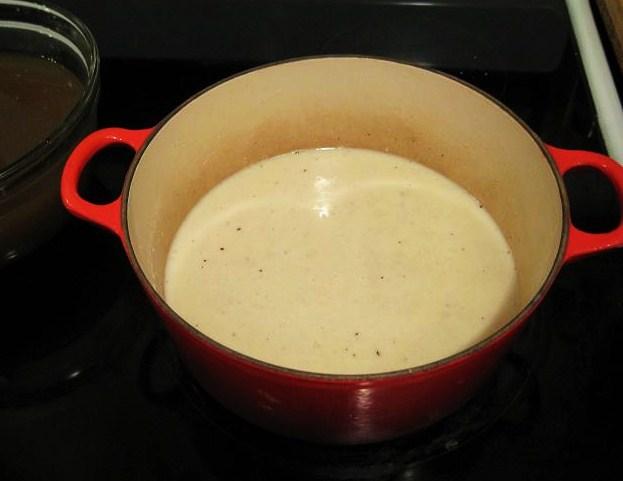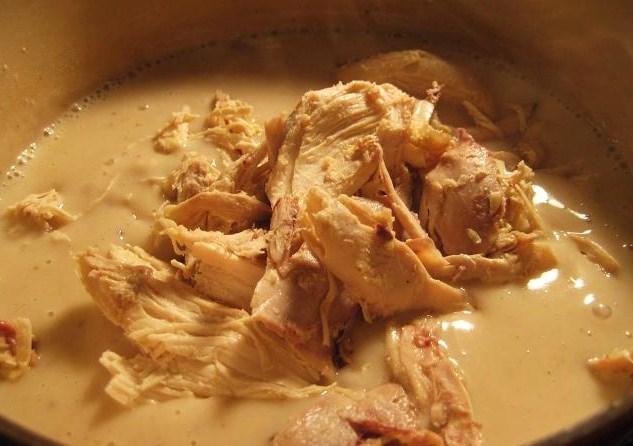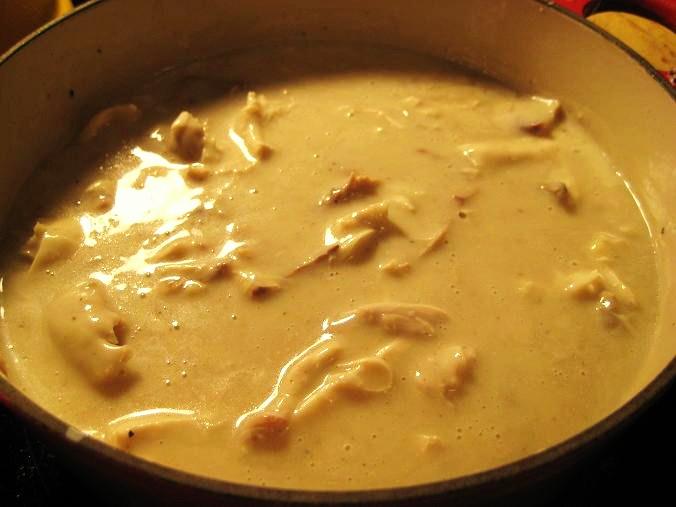-
Posts
5,035 -
Joined
-
Last visited
Content Type
Profiles
Forums
Store
Help Articles
Everything posted by David Ross
-
For these "slicks" or noodle-style dumplings do you have to let them rest after you make them and before you add them to the stew or do you just put them right into the hot stew like we do with our drop-style dumplings?
-
Glad that it worked for you. Sometimes a little butter goes a long way in adding just that bit of flavor boost you need. If you look at a lot of recipes from the 50's and 60's you'll often see "salad oil" as an ingredient. From what I've been able to find, it's basically what we now call vegetable oil and corn oil. Today it's morphed into the more diet friendly canola oil.
-
Your Chicken and Dumplings look delicious--especially the Dumplings! Just because of your photo, I'm not so apprehensive of the "noodle-stlye" and I'll be trying that recipe next time. Thanks.
-
I'm enjoying seeing the variations of chicken and dumplings displayed here in our cook-off. There's definately a "traditional vs. new" preference out there, and I especially like the recipes that give one the option to create a quick chicken and dumpling dish in just a few hours. My dish was very good, but I don't think everyone would want to stretch things out over the course of about three days to re-create it.
-
And your broth appears to be more on the "soupy" side as opposed to my "creamed chicken" dish, yes? How did you like the consistency of the broth?
-
Looks like gnoochi to me too. Anyway, I love, love, love Chicken and Dumplings. But sometimes my dumplings have a raw flour taste-bitterish- as if I am not cooking them enough. I keep trying to cook them longer and longer in hopes that that is the problem, but is it just that I am using a crappy recipe? I have also tried them with 00 flour and that didn't help. Is it the baking powder? I keep trying this recipe, because I remember them being good when someone ELSE made them. 1 1/3 cups all purpose flour 2 tsp baking powder 1/2 tsp salt 2/3 cup milk 2 tablespoons oil Recipe calls for 10 minutes each side. I go at least 15 each side, but it does sometimes suck up all my broth. My recipe for the chicken and broth is really simple and I love it. It's always perfect. I usually stew whatever chicken parts I have on hand (making sure there is enough dark meat) with onions, carrots, celery, parsley, sometimes leak, S&P, and fresh thyme. Very simple yet pleasing to my palate!!! I always debone the chicken and add back to the broth and lay the dumplings on top to cook. I am going to make this dish again tomorrow. Of course I'm not the dumpling expert here, but I'm wondering if you need a bit more fat in the mix so that the dumplings don't have that raw taste? What kind of oil do you use--is it salad oil or olive oil? Maybe that is the problem. The old-style recipes typically called for plain shortening or lard and that would probably give more flavor than oil. And whole milk would also give more flavor than 2% or skim milk. Finally, you might want to add a beaten egg to the dumpling batter. I'll be interested to see if those few changes maybe give you better results. Anyone else have any ideas?
-
I am literally feeling your dumpling anticipation and I know they will be delicious. I felt the same way when I was making my dumplings. I'm especially interested in how much time your dumplings will need to cook in the stew so don't forget to record that timing for us. Good luck Chris.
-
Nice dish, David, though it seems to me that it's more like creamed chicken than the a soup-like concoction normally associated with C&D (said the guy who browned his dumplings!) It's obvious you've done some research. Is there an historical basis for this sort of modification? Well, sort-of, which isn't much of a definitive answer! The dumplings were definitely historical from the perspective that they were pulled exactly out of a cookbook published in 1945 with the only "modern" modification being the addition of fresh thyme leaves and chopped, fresh Italian parsley. Now the "chicken gravy" is a different matter--and much harder for me to argue as being a recipe based in history in terms of its authenticity. I pulled it from my Chicken with Biscuits base, our discussions here, and a number of my vintage cookbooks. Those cookbooks range from the late 1890's into the early 1960's. I found that the recipes for Chicken and Dumplings ranged from soupy and watery to recipes with the consistency of stews and chowders. Many of the recipes did allow for the cook to thicken the stew with a mixture of flour and milk. And I should note that I didn't do any research of recipes on the Internet--it was my own recipes, our discussions and hard cover vintage cookbooks that led to the final dish. Now my dish is on the "thicker" end of the spectrum and could easily be adapted as a "Creamed Chicken on Toast," or "Creamed Chicken with Dumplings" or "Creamed Chicken on Biscuits" recipe.
-
As the chicken gravy was stewing on top of the stove, I turned to the dumplings. Now mind you, I have never, ever, made a dumpling. I was quite nervous about this stage of the recipe. Reading through our posts here, I was not, at my stage of naievete, going to even attempt to cut dough into strips ala dumplings. Of the eight dumpling recipes Ms. Berolzheimer offered in her cookbook, I settled on the "Feather Dumpling" recipe. I suppose it was named after a feather for its finished texture. One would find out in the final tasting. I hoped. The only addition I made was to add a bit of fresh thyme and parsley for flavor. The recipe called for 2 cups flour, 1 tsp. salt, 4 tsp. baking powder, 1/4 tsp. pepper, 1 egg, 3 tbsp. melted butter and "about" 2/3 cup milk. After mixing these ingredients together, the batter was what I would describe as "semi-stiff"- Now I was quite nervous. The recipe called for the cook to drop the batter by teaspoons into boiling liquid. Since I hadn't done this before, I improvised. I used two large spoons and sort of shaped large spoons of dumpling batter and dropped that into the hot, not boiling, chicken gravy. The recipe called one to "cover, very closely, and cook for 18 minutes." I couldn't resist temptation, so I had to uncover the pot after about 3 minutes and take a look at my dumplings. I shouldn't have looked. Uncovering an uncooked dumpling at the 3-minute mark is not a pretty sight. The poor little things looked like they were going to melt in my precious chicken gravy- I covered the pot, trusted the editors of the American Woman's Cookbook who I am sure knew that exactly 18 minutes was in fact the right amount of cooking time for a Feather Dumpling and I left well alone. This was the result- As you can see in this close-up, the dumplings did not suffer from the indignity of my uncovering of the pot. They were light and fluffy inside, yet with a nice outside, almost biscuit-like outside cover. As some of you have mentioned, the dumplings are a delicious counter in terms of texture and flavor to the chicken gravy. And what a wonderful taste sensation when you spoon a bit of this little dumpling together with some of that warm gravy, the two melt together and this is just one of the most delicious dishes I think I have ever tasted- I'm looking forward to seeing your Chicken and Dumplings dishes.
-
As I read through our discussion points, it became apparent early on that the only part of my Chicken Pie recipe that would relate to our cook-off would be the stock and the chicken. I decided to go with the "Cracker-Barrel" style base for my stew--a white gravy with only chicken. No vegetables. This is a photo of the finished chicken stock. It's really what we could call a chicken jelly as it has that kind of consistency. Those little white bits are actually nice little globs of fat. I used this stock to make what I am calling "chicken gravy." The chicken gravy was made by whisking together 1/2 cup of Wondra flour with 1 cup of half and half. Cream would have been too thick and heavy for my tastes, milk too thin. I only use Wondra for gravies and sauces because it is milled especially fine for these types of recipes. If you've never used it, try it. Your sauces and gravies will come out incredibly smooth and silky with nary a lump. Once the base of flour and half and half is poured into a heated pot the work of whisking in the chicken stock begins. I added about 4 cups of chicken stock to make a thick gravy, then seasoned it with salt and black pepper- Next into the pot went the reserved chicken meat from the chickens that made the stock. I didn't measure the amount of chicken meat, I just put in the amount that looked good for the size of the pot. I added a small bit of fresh thyme and Italian parsley to the gravy at this point- This is the pot with the "chicken gravy" as I'm calling it, awaiting the next important stage. I'll be showing everyone my attempts to make a drop-style of dumpling. For the dumplings I decided to keep things in a retro-style, relying on a recipe from the aforementioned American Woman's Cookbook of 1945, edited by Ruth Berolzheimer. Here is the pot waiting for a recipe of "Feather Dumplings"-
-
Well, a big long thank you for this wonderful, gracious story about your dear Grandmother Elaine Mills Kinsey. This is just the type of family memory that in my humble mind speaks to why we love this simple, satsifying dish that we call Chicken and Dumplings. I just love stories like this . And your story poked me into realizing that I have forgotten to add a very important family element of my own to my story about Chicken and Dumplings and my preparations for this Cook-off. As I was getting ready to make Chicken and Dumplings I called my 86-year old Mother, Janet Edna Pink Ross. (Don't worry, Mother does not fear having her age revealed). My Mother told me she's never made Chicken and Dumplings, yet she had it many times when she was a young girl growing up in Twin Falls, Idaho--most memorably at the home of my Great Aunt Bertie Pink. Bertie Pink was born sometime around 1890 or so, we don't really know. What we do know is that she never had a real job and the day she stopped driving, sometime around 1960 or so, she parked the 1924 Cadillac in the garage and never drove it again. Bertie's only job was to care for her Mother, Jenny and her Father, Max, and to tend to the small farm they kept. Bertie was a wonderful cook. I especially remember her delicious fruitcake soaked in large amounts of brandy and her delicious cold fried chicken that she always packed for us each summer when we drove home to Oregon. I imagine those were the same chickens she used for her Chicken and Dumplings. Now these were what we today call "free-range, organic" chickens. In 1934 in Twin Falls, Idaho they were chickens that pecked at grass and bugs and lived a very happy life. Then they ended up in Bertie's stewpot. Mother told me she thought Bertie left me a hand-written recipe for Chicken and Dumplings in her recipe box, but I never found one. There were recipes for just about everything else, including divinity and escalloped potatoes, all written in long-hand with a fountain pen, yet I never found a recipe card for Chicken and Dumplings. So here's to Elaine Mills Kinsey and Bertie Pink and Chicken and Dumplings for all.
-
I like to mix salted anchovies with softened butter and maybe some fresh herbs. Fresh oregano is especially good. Then chill in the refrigerator until really hard. Cut a nice thick slab of the cold anchovy butter and put it on a grilled steak. Delicious.
-
Using my unscientific recipe for chicken stock yielded 14 cups finished stock.
-
Everyone's feedback has invaluable to me. Our discussions have made me realize that there are even greater differences between Chicken Pie with Biscuits and Chicken and Dumplings than I had realized before we began our Cook-Off. I've started with the base for my Chicken and Dumplings--Chicken Stock. I'll be using the stock to then make the "gravy" for my dish. The Stock- I started with my tried and true recipe for making chicken stock. I think you may find it a bit uncoventional in that I don't do much straining of all the foam and mucky stuff that floats to the top of the stock as it stews down. I might skim the stock about 3, maybe 4 times, that's it. I suppose it's mainly due to laziness on my part. Maybe I'm just stubborn and don't think it's really necessary, or then again, since the final stock is so delicious and has such a concentrated chicken flavor maybe I've proven my own theory right in that I think spending all that time to skim away flavor isn't necessary. In any case, I put the below ingredients in the largest Le Creuset pot made and cover the whole lot with water and let it simmer on the stovetop for about 6 hours. Two roasting chickens, 2 yellow onions, skin on and cut in half, 2 heads garlic cut in half, celery, carrot, rosemary, parsley, thyme, allspice berries, 2 bay leaves, black peppercorns- After hours of cooking in the aromatics, you can almost taste this wonderfully flavorful stock and tender, moist, chicken- The vegetables and spices are strained out and the stock is returned to the pot to reduce. The meat is pulled off the chicken and reserved. The bones are also returned to the pot to flavor the stock as it reduces. This second cooking of the stock takes about two more hours or so. I didn't weigh the chicken meat but it's a lot. More than enough for a nice big pot of Chicken and Dumplings-
-
I'm probably going to add some fresh thyme and sage to a dumpling recipe out of one of my vintage cookbooks. I was wondering if anyone has considered the type of chicken they'll be using? I use roasting hens to make chicken stock. I've always had great success using basic supermarket roasting hens to make chicken stock--the stock is far better than what you can buy in the market and the meat stays incredibly moist. I don't find any need to buy more expensive, free-range, organic chickens or larger roasting hens or capons. Any thoughts?
-
Ever have chicken noodle soup? or matzah ball soup? or even consomme a la royale? Same idea. While the dumplings/noodles/mazta ball are merely cooked dough, they soak up the soup/liquid component and become flavorful. It is basically experiencing the the flavor of the soup with a different texture. So part of their point is textural contrast. In another manner of thinking, assuming you put veggies in the soup, the dumplings create a complete dish (veggies, protein, starch). As a rustic dish, this makes complete sense...so from that perspective the point is "carbs". When I was reviewing my vintage cookbooks for Chicken and Dumpling recipes, I found it interesting at the number of different recipes for dumplings there actually were years ago--egg, feather, for Irish stew, for Pepper Pot, fruit, liver, peach, potato and whole-wheat were just a few of the variations I came upon. Things are a bit different today. I have a sense dumplings are often forgotten, but as noted above, dumplings are a part of some of the most noted and classic of dishes. I've been thinking about my Great Aunt Bertie as we've been discussing Chicken and Dumplings. I called my Mother and she remembers Aunt Bertie making Chicken and Dumplings for her when she was young. Aunt Bertie was not someone who would speak of "carbs" or the "textural contrast between the dumplings and the tender peas in the delicate broth of the stew," yet I'm pretty sure she knew when she made Chicken and Dumplings using the hens from the barn and the vegetables from the garden she knew she was making a good, wholesome meal.
-
Welcome to the latest eGullet Cook-off, Chicken and Dumplings, Number 51 in our Cook-Off Series. You’ll find the complete Cook-off Index here. The eGullet Cook-off Series has covered such far-ranging and delicious topics as Cold Soups to Ossobuco and Enchiladas. Our last Cook-Off captivated us with the earthy aromas of a slow-braised Lamb Stew wafting through the kitchen, (and down the halls of an apartment building). As the cold, windy drafts of January blow us into a new decade, there are still plenty of winter days ahead and that's the perfect weather to savor a favorite comfort dish, Chicken and Dumplings. (For more discussion on this classic dish, you can read through our Chicken and Dumplings Topic here). While I consider myself somewhat of an accomplished cook when it comes to another classic comfort dish, Chicken Pie with Biscuits, I’m a novice Chicken and Dumplings cook. As I began to contemplate the task of cooking Chicken and Dumplings, I soon discovered that while both dishes share some common cooking techniques, they also have a number of subtle yet quite distinctive differences. I also uncovered a number of subtleties within the hundreds of recipes one finds in the Chicken and Dumplings library. The 1913 edition of the Boston Cooking School Cookbook by Fannie Merritt Farmer doesn’t include a specific recipe for Chicken and Dumplings. Like other cookbooks of the day, it does have a recipe for a “Chicken Fricassee,” described in part as “a fowl, cleaned and cut-up” and then sautéed in pork fat and stewed in either water or stock and served with a white or brown sauce. Dumplings were prepared separately from the chicken, then steamed and served with gravy on the side. According to the 1945 edition of the “American Women’s Cookbook,” (Consolidated Book Publishers of Chicago), the opening instructions called for “cleaning and singeing the feathers of the bird.” Most cooks were apparently still raising chickens in their backyards in the 1940’s, (or at least buying freshly killed birds at the market). The cook was instructed to simmer the bird “in plain water for a very long time-an old fowl will require at least 3 or 4 hours slow cooking.” Folks must have liked their food plain back then as the instructions continued with these gentle words-“if desired, an onion and a stalk of celery may be cooked with the chicken before the dumplings are added.” The chicken was removed from the pot and the stewing liquid was thickened into a gravy with flour and milk. The dumplings were cooked in the gravy, which was then spooned over the chicken before the platter was brought to the table. I typically use 4 ½ lb. roasting chickens to make chicken stock and for the base of stews. Should I be using large roasting hens or capons instead? I’ve used frozen capons in the past for braised chicken dishes, and while they are advertised as having “fuller” flavor, I’ve found them bland and the meat stringy. I assume that’s due in part to the freezer burn they acquire by sitting for years in the back cases of supermarket freezers. I’m wondering what others have experienced with larger chickens. I’ve always been under the impression that for stewed chicken dishes one uses the chicken to make a stock enriched with vegetables and aromatics and then the meat of the chicken is put back in the finished stock. Is a true Chicken and Dumpling dish made by poaching a chicken in plain water with no seasonings? Is the flavoring of the liquid a matter of regional or family heritage? Now following on that thought, can the “stew” for Chicken and Dumplings be thickened with a roux? Does it have to stay “nude” as it were? If we use a roux, can the roux be further thickened with cream or half and half? What about those dreaded little peas and carrots that go into a Chicken Pie? Are they banned in Chicken and Dumplings? What about pearl onions, sliced mushrooms, diced potatoes, or maybe some chopped celery added to our Chicken and Dumplings? And what about these little puffs of flour and shortening that we call Dumplings? Is it a pre-requisite that dumplings be made with all-purpose white flour? What about using whole wheat flour, or semolina, or cornmeal, or even blue cornmeal? Should we add some fresh herbs or some nice Oregon Rogue River Bleu cheese to our dumplings? Is it an afront to tradition to even suggest putting an artisanal cheese in your dumplings? And does the size of the dumpling matter? Should they be the size of the end of your thumb, or the size of a big softball? At this point I seem to have more questions than answers. I know I can adapt my Chicken and Biscuit recipe by substituting beautiful little Dumplings for the Biscuits and I know my rendition will be delicious. But will I be true in creating an authentic Chicken and Dumplings dish?
-
I'm liking it very much. It seems as though Bourdain has passed through his "Reefer Madness" phase where every other sentence used to be a reference to either drugs or an Iron Butterfly album. There seems to be more focus on the food this season and that's the way I like it. So far.
-
Grilled Pork Chop with Green Olive Sauce- The sauce was something I just came up with while I was wandering through the grocery store. I wanted a piquant flavor in the sauce to cut through the richness of the pork so that's why I settled on the flavors of green olives. I decided on green olives stuffed with pimentos and minced them in a blender with some olive oil and a bit of the brining juice from the olives. I added some black pepper, dried marjoram, cumin seed and celery seed. I served the pork with cornbread that I mixed with salsa, braised leeks and a coleslaw that I tossed with a bottled poppyseed dressing. Enjoy.
-
What I call "frizzled onions"--sweet onions, sliced very thin, soaked in milk, then coated in flour and "frizzled" or deep-fried in hot oil until golden brown. Takes only about 2 minutes, then you season them with Old Bay and paprika-yes, a bit of an odd seasoning mix but it works with the flavor of the sweet onion.
-
I used to stuff my chickens with both lemons and a head of garlic but as mentioned above, I came to the realization that it didn't do anything other than result in wasting a good fresh lemon and head of garlic. The lemon barely got warmed and basically soaked up the juices of the chicken yet hardly released any lemon oil or lemon scent into the chicken--at least none that one could taste. I moved on to placing lemon halves and cut-up garlic heads in the bottom of the roasting pan with the thought that the juices from the roasting chicken would marry with the lemon and garlic and give me a delicious lemon-garlic sauce to baste the chicken. Well, sort of. Putting the lemon and garlic in a dry roasting pan basically resulted in a burned lemon and little juices to baste the chicken. What little juice there was was burned and acrid. The end result is that now I just season the inside of the chicken cavity with salt and butter and rub the outside with either olive oil or butter. I'll place the lemons and a cut head of garlic in the bottom of the roasting pan under the chicken and then I'll baste the chicken with a combination of fat and chicken stock-usually butter and stock but sometimes olive oil and stock. The result is a lemon-garlic flavored basting sauce without the burnt/acrid taste. This was one of those cases where the basic recipe, (roast chicken stuffed with lemon), sounded good but in practice really didn't work for me.
-
Well, the darn little frozen buggars are only available at the local Walmart Supercenter during the late Fall and into the Winter months here in Spokane. While I find them convenient, I also don't like the fact that frozen pearl onions take on little ice particles while frozen which means when they thaw/cook they tend to get watered down and in my opinion have a watered down taste. I resign myself to just use fresh ones and suffer through having to blanch them for 20-30 seconds in hot water and then peel off the outer skin. Since I only do that once a year when I make my Mother's creamed onions for Christmas dinner I guess it's o.k.
-
This is my version of Chicken and Dumplings. I've posted this dish before, but for the benefit of our new Members here it is again. This is not a first of the year diet dish as it employs good things like cream and butter and cheese in generous amounts. The actual recipe is called "Chicken Pie with Biscuits" and is based on a series of recipes that ran in an old issue of Saveur magazine in a story on Church Suppers that featured the dish. It's basically a three-day process that starts on day one with making your own chicken stock-you stew a whole chicken in a pot with water, (and a few other ingredients). The meat is taken off the bones and kept for the casserole while the bones are returned to the pot to flavor the stock. On day two you boil the stock down to concentrate the flavor and then on day three you use the stock to make the chicken pie. The pie is a combination of cream, flour, butter, the chicken meat, carrots, celery and peas. I use a biscuit recipe that includes cream of tartar and this time I added some cheddar cheese to the biscuits. Enjoy.
-
Great reports. Thank you!
-
Chicken with Calvados and Roasted Fennel: This is a very French, very rustic, very wintry dish that is simple to make during this busy week of pre-Christmas activities. Now my technique may vary from traditional recipes you've read, but it works--and good. Simply cut-up a large whole chicken. Melt about 6 tablespoons of salted butter in a heavy Le Creuset roasting pan, (if you have Le Creuset it's the best). Add the chicken pieces, skin side down. Salt and pepper the chicken and scatter in some peeled garlic cloves. Roast the chicken in a 375 oven about 30 minutes. Now add some sliced fresh fennel, a Granny Smith apple, unpeeled but cored, and a few torn leaves of fresh sage. Turn the chicken over, skin side up, and roast the chicken another 30 minutes or so. Now slog in about a cup of heavy cream and let the chicken roast another 20 minutes until it is the above golden brown color. Remove the chicken from the oven. Take the chicken out of the roasting pan and place it on a large serving platter but leave all the vegetables and apples in the roasting pan with the cream and juices. Heat up some Calvados, use the authentic stuff--not the American stuff called "Applejack Brandy." Light it with a match and carefully pour it into the roasting pan. The flaming Calvados will mingle with that cream, butter and chicken roasting juice and give you a delicious sauce. Pour the sauce and fennel around the chicken pieces and garnish with more fresh sage.



